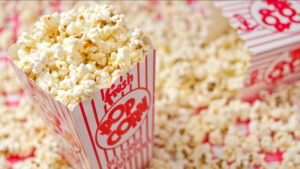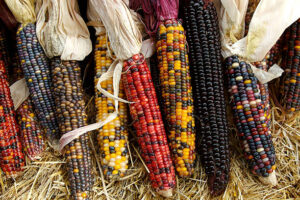Every year, on January 19th, the United States of America celebrates Popcorn Day. And short of Thanksgiving (last Thursday in November), Apple Pie Day (May 13th), Root Beer Float Day (August 6th) or Peanut Butter And Jelly Day (April 2nd), I can think of no other food holiday that is as quintessentially American.

We love the stuff. It’s everywhere.
No movie or baseball game is complete without it. According to the good folks at Encyclopedia Popcornica, Americans consume 16 billion quarts of popped popcorn every year, equaling 52 quarts per person. A quart a week for each of us, then.
Popcorn is so ingrained (ahem) in American culture, that we not only eat it at ball games and the movies, we eat loads of it at home, and – like the Balkans, who must have got the idea from us – we use it to decorate Christmas trees.

We even briefly used it as packing material. American films are often derided by foreign critics as “popcorn entertainment.” Popcorn even played a major role in the development of that other great American invention, the microwave oven.
And it is truly American, in origin and in history.
Popcorn is of course partially dried corn kernels. Corn (proper name Maize) is native to the Americas. Historical references to “corn” in other countries, such as the UK or Egypt, actually refer to wheat (UK), or barley (Egypt). The term “corn” actually meant “the grain most used in a specific place”, and since maize was the grain most used in America, it took the name “corn” and kept it to this day.
Native Americans were of course growing the stuff long before Europeans ever landed, and popping it too. In fact, it’s believed by historians that the first use of corn was popping. The oldest specimens of dried corn ears were found in New Mexico. They are about 4,000 years old.
When the Spanish Conquistador Hernan Cortes de Monroy y Pizarro (try saying that through a mouthful of popcorn) encountered the Aztec civilization in 1519, he found that not only was popcorn a staple part of their diet, but they were also using it to decorate ceremonial headdresses and necklaces, and garlanding statues of their gods with the stuff.

According to an early account, the Aztec called it momochitl and used it specifically in ceremonies honoring Tlaloc, the god of rain and fertility. Apparently the fluffy white grains represented hailstones. An account of Peruvian Indians in 1650 mentions them popping corn, which they called pisancalla.
It’s in 1893 that popcorn became American in the modern sense. Ever since the Native People had shown the English settlers how to grow and use corn, popcorn had been around and fairly popular as a snack and as Christmas tree decorations. Corn was popped in a wire rack over an open flame. But at the Chicago World’s Fair, Charles Cretors unveiled the world’s first mobile popcorn machine. Not only was the machine mobile, it was also to first to use steam as the cooking mechanism, and thence created a much more evenly cooked batch of popcorn. It was an instant hit, and the grand tradition of selling popcorn at picnic grounds, fairs, and sporting events was born.
As early as 1912, popcorn was being sold at American cinema parlors. Incidentally, it was the same World’s fair that Cracker Jacks were born.

Introduced by FW Rueckheim as Caramel Corn, the recipe was slightly altered by his brother Luis, and the name changed to Cracker Jacks. (Many thanks, Wikipedia)
Popcorn was even one of the few success stories of the Great Depression. Because it was relatively cheap at 5 to 10 cents a bag, popcorn was one of the few food luxuries people down on their luck could afford. Farmers switched to corn as a crop and were able to hold on through the toughest years. There’s even one story of a banker who, having seen his bank fail and his properties lost, switched to selling popcorn and was eventually able to buy back three of the farms he’d lost.
Popcorn remained popular during WWII, when sugar rationing meant that fewer sweets were eaten and people snacked on popcorn instead. And just after the war, Percy Spencer of the Raytheon Manufacturing Corporation turned to popcorn when he set about developing microwave technology for domestic use. Because of the way popcorn cooks (from the inside out-of which more anon) it was ideal for Spencer’s experiments. So it’s thanks at least in part to popcorn that we have microwave ovens. Today, the vast majority of popcorn sold for use in the home is in microwave bags, no doubt making Orville Redenbacher a very wealthy man indeed.
What makes it go BANG?
So what makes popcorn pop? Well steam, basically. And it has to be a certain kind of corn. Most types of corn won’t pop as their internal structure doesn’t allow for it. Your kernel of popcorn has three layers; a hard outer shell, an inner layer of soft starch, and a drop of water at the very center. When heated to a high enough degree, the water turns to steam and the layer of soft starch into a “superhot gelatinous goop” (Thanks again, Encyclopedia Popcornia). Eventually, as the heat rises, the pressure inside the kernel builds until it explodes and the steam is released. Some Native Americans believed that a spirit lived inside each kernel, and would exit angrily as steam when the kernel was heated. Kernels that don’t pop are known in the popcorn industry as “old maids”, which I think is rather rude.
By itself, popcorn is actually pretty good for you. It’s a whole grain, low in calories and fat, and is sodium and sugar-free. It’s all the butter, salt and oil (along with other flavourings) that we add to popcorn that take it off the “diet food” list. Movie popcorn is an especially bad offender. The Centre For Science In The Public Interest published a report in the mid-90s that found that a “medium size buttered popcorn contains more fat than a breakfast of bacon and eggs, a Big Mac and fries, and a steak dinner combined.” What I personally find most worrying about this is that popcorn isn’t at all filling for me, so after that bucket of popcorn I could quite happily eat one or all of the above.
In conclusion
But who cares? We’ve found ways to cook popcorn – like the microwave – that don’t require so much oil or fat. And it’s part of our American way of life. We associate it with fun. Sure, an afternoon spent with popcorn may mean an evening spent with dental floss, but that can only then be a reminder of what a good time you’ve just had.
So I shall happily celebrate popcorn today. in fact, might just go fix myself a nice big bowl. With extra butter, of course . . .
